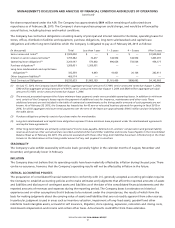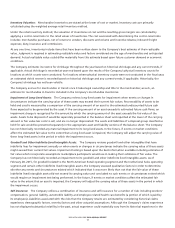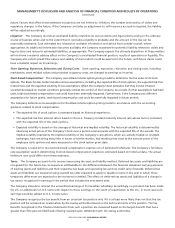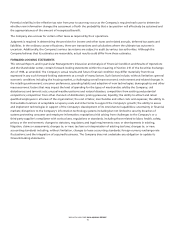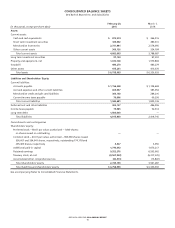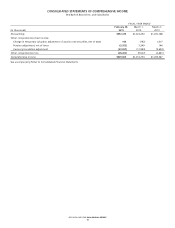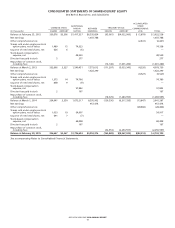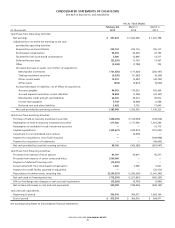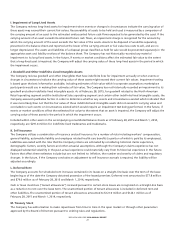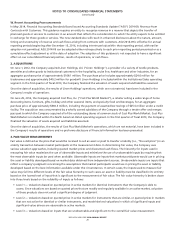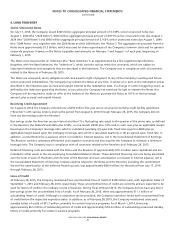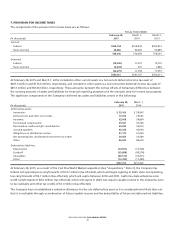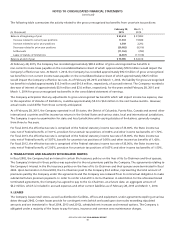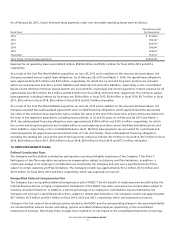Bed, Bath and Beyond 2014 Annual Report Download - page 24
Download and view the complete annual report
Please find page 24 of the 2014 Bed, Bath and Beyond annual report below. You can navigate through the pages in the report by either clicking on the pages listed below, or by using the keyword search tool below to find specific information within the annual report.F. Investment Securities
Investment securities consist primarily of U.S. Treasury Bills with remaining maturities of less than one year and auction rate
securities, which are securities with interest rates that reset periodically through an auction process. The U.S. Treasury Bills are
classified as short term held-to-maturity securities and are stated at their amortized cost which approximates fair value. Auction
rate securities are classified as available-for-sale and are stated at fair value, which had historically been consistent with cost or par
value due to interest rates which reset periodically, typically every 7, 28 or 35 days. As a result, there generally were no cumulative
gross unrealized holding gains or losses relating to these auction rate securities. However, beginning in mid-February 2008 due to
market conditions, the auction process for the Company’s auction rate securities failed and continues to fail. These failed auctions
result in a lack of liquidity in the securities, and affect their estimated fair values at February 28, 2015 and March 1, 2014, but do
not affect the underlying collateral of the securities. (See ‘‘Fair Value Measurements,’’ Note 3 and ‘‘Investment Securities,’’ Note 4).
All income from these investments is recorded as interest income.
Those investment securities which the Company has the ability and intent to hold until maturity are classified as held-to-maturity
investments and are stated at amortized cost. Those investment securities which are bought and held principally for the purpose of
selling them in the near term are classified as trading securities and are stated at fair market value.
Premiums are amortized and discounts are accreted over the life of the security as adjustments to interest income using the
effective interest method. Dividend and interest income are recognized when earned.
G. Inventory Valuation
Merchandise inventories are stated at the lower of cost or market. Inventory costs are primarily calculated using the weighted
average retail inventory method.
Under the retail inventory method, the valuation of inventories at cost and the resulting gross margins are calculated by
applying a cost-to-retail ratio to the retail values of inventories. The cost associated with determining the cost-to-retail ratio
includes: merchandise purchases, net of returns to vendors, discounts and volume and incentive rebates; inbound freight
expenses; duty, insurance and commissions.
At any one time, inventories include items that have been written down to the Company’s best estimate of their realizable
value. Judgment is required in estimating realizable value and factors considered are the age of merchandise and anticipated
demand. Actual realizable value could differ materially from this estimate based upon future customer demand or economic
conditions.
The Company estimates its reserve for shrinkage throughout the year based on historical shrinkage and any current trends, if
applicable. Actual shrinkage is recorded at year end based upon the results of the Company’s physical inventory counts for
locations at which counts were conducted. For locations where physical inventory counts were not conducted in the fiscal year,
an estimated shrink reserve is recorded based on historical shrinkage and any current trends, if applicable. Historically, the
Company’s shrinkage has not been volatile.
The Company accrues for merchandise in transit once it takes legal ownership and title to the merchandise; as such, an
estimate for merchandise in transit is included in the Company’s merchandise inventories.
H. Property and Equipment
Property and equipment are stated at cost. Depreciation is computed primarily using the straight-line method over the
estimated useful lives of the assets (forty years for buildings; five to twenty years for furniture, fixtures and equipment; and
three to seven years for computer equipment and software). Leasehold improvements are amortized using the straight-line
method over the lesser of their estimated useful life or the life of the lease. Depreciation expense is primarily included within
selling, general and administrative expenses.
The cost of maintenance and repairs is charged to earnings as incurred; significant renewals and betterments are capitalized.
Maintenance and repairs amounted to $120.3 million, $111.9 million and $106.1 million for fiscal 2014, 2013 and 2012,
respectively.
NOTES TO CONSOLIDATED FINANCIAL STATEMENTS
(continued)
BED BATH & BEYOND 2014 ANNUAL REPORT
22


